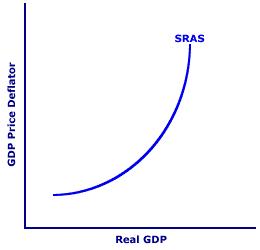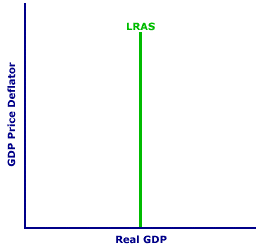
|
|
INDEX: A measure of the relative average of a group of items compared to a given base value. Index measures are commonly used in economics to combine and compare diverse measures. One common type of index measure is for prices, such as the Consumer Price Index and the Dow Jones Industrial Average of corporate stock prices. Another noted type of index measure is to track macroeconomic activity, especially the index leading economic indicators. Indexes are usually weighted averages rather than simple arithmetic means that are measured relative to a base value or period. The Consumer Price Index, for example, measures the prices of consumer good, weighted by the quantities purchased. The value of a given period is then stated relative to a base year value, which generates a pure, "unitless" number in the range of 100 (give or take).
Visit the GLOSS*arama
|
|


|

|
                           AGGREGATE SUPPLY SHIFTS: Changes in the aggregate supply determinants shift both the short-run aggregate supply curve and the long-run aggregate supply curve. The mechanism is comparable to that for market supply determinants and market supply. There are two options--an increase in aggregate supply and a decrease in aggregate supply. An increase in resource quantity or quality or a decrease in resource price shifts one or both of the aggregate supply curves to right. A decrease in resource quantity or quality or an increase in resource price shifts one or both of the aggregate supply curves to left. | Shifting the SRAS Curve | 
| Shifting the LRAS Curve | 
|
To see how this works, consider the short-run aggregate supply curve and long-run aggregate supply curve presented in the exhibit to the right. The short-run aggregate supply curve, abbreviated SRAS, is in the top panel and the long-run aggregate supply curve, abbreviated LRAS, is in the bottom panel.- The short-run aggregate supply curve is positively sloped and captures the specific one-to-one relationship between the price level and real production.
- The long-run aggregate supply curve is vertical at the full-employment level of production, indicating that real production is independent of the price level.
The ceteris paribus factors, that is, the aggregate supply determinants, are assumed to remain constant when these curves are constructed. Similar to other determinants, the aggregate supply determinants shift these two aggregate supply curves. A change in the determinants can either increase or decrease one or both of the aggregate supply curves. - Short-Run Aggregate Supply: Consider first the short-run aggregate supply curve. An increase in short-run aggregate supply is illustrated by a rightward shift in the SRAS curve in the top panel. A decrease in short-run aggregate supply is illustrated by a leftward shift. Click the [Increase in SRAS] or [Decrease in SRAS] buttons for a demonstration.
- Long-Run Aggregate Supply: Now consider the long-run aggregate supply curve. An increase in long-run aggregate supply is illustrated by a rightward shift in the LRAS curve in the bottom panel. A decrease in long-run aggregate supply is illustrated by a leftward shift. Click the [Increase in LRAS] or [Decrease in LRAS] buttons for a demonstration.
What does it mean to have an increase in supply? It means that for every price level, the business sector is willing and able to supply more real production. A decrease in supply is the exact opposite. For every price level, the business sector is willing and able to supply less real production.Shifts of the short-run or long-run aggregate supply curves, brought about by such things as education or technology, an increase in the size of the population or the capital stock, or changes in wages or energy prices, can be the source of disequilibrium in the aggregate market. Such disequilibrium then results in changes in the price level. The key is that aggregate supply determinants CAUSE shifts of the aggregate supply curves which CAUSE disequilibrium which then CAUSES changes in the price level. This suggests an important difference between two related changes--a change in aggregate supply and a change in real production. - A change in aggregate supply is any shift of either of the aggregate supply curves. With this change, the entire curve shifts to a new location. A change in aggregate supply is caused by a change in the aggregate supply determinants. This is comparable to a change in supply in the analysis of the market.
- A change in real production is a movement along a given aggregate supply curve. This change involves the movement from one point on the existing curve to another point on the SAME curve. The curve does not move. A change in real production is caused by a change in the price level, and ONLY a change in the price level! This is comparable to a change in quantity supplied in the analysis of the market.
While a change in real production, as a movement along the curve, applies in principle to both short-run and long-run aggregate supply curves, because real production does not change in the long run, from a practical standpoint, a change in real production primarily applies to the short-run aggregate supply curve.

Recommended Citation:AGGREGATE SUPPLY SHIFTS, AmosWEB Encyclonomic WEB*pedia, http://www.AmosWEB.com, AmosWEB LLC, 2000-2024. [Accessed: April 29, 2024].
Check Out These Related Terms... | | | | | | | | | | | | |
Or For A Little Background... | | | | | | | | | | | |
And For Further Study... | | | | | | | | | | |
Search Again?
Back to the WEB*pedia
|



|

|
GRAY SKITTERY
[What's This?]
Today, you are likely to spend a great deal of time strolling through a department store hoping to buy either clothing for your kitty cats or a set of luggage without wheels. Be on the lookout for infected paper cuts.
Your Complete Scope
This isn't me! What am I?
|

|
|
Potato chips were invented in 1853 by a irritated chef repeatedly seeking to appease the hard to please Cornelius Vanderbilt who demanded french fried potatoes that were thinner and crisper than normal.
|

|
|
"Something in human nature causes us to start slacking off at our moment of greatest accomplishment. As you become successful, you will need a great deal of self-discipline not to lose your sense of balance, humility and commitment." -- H. Ross Perot
|

|
NFA
National Futures Association
|

|
|
Tell us what you think about AmosWEB. Like what you see? Have suggestions for improvements? Let us know. Click the User Feedback link.
User Feedback
|


|


